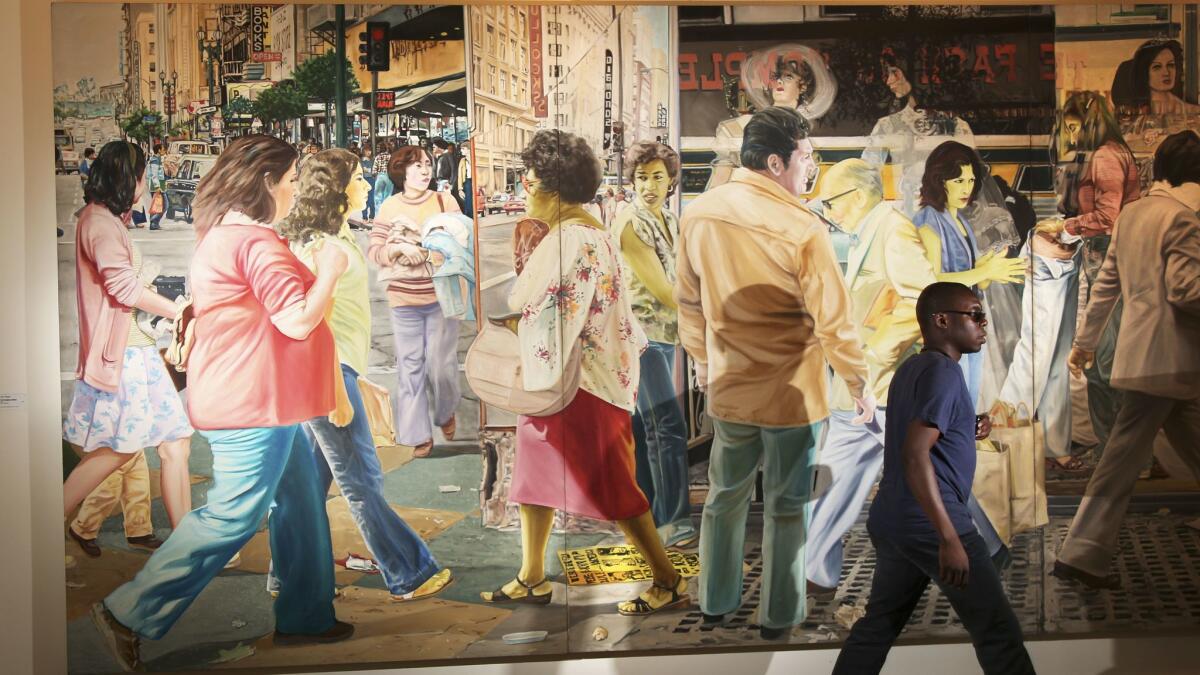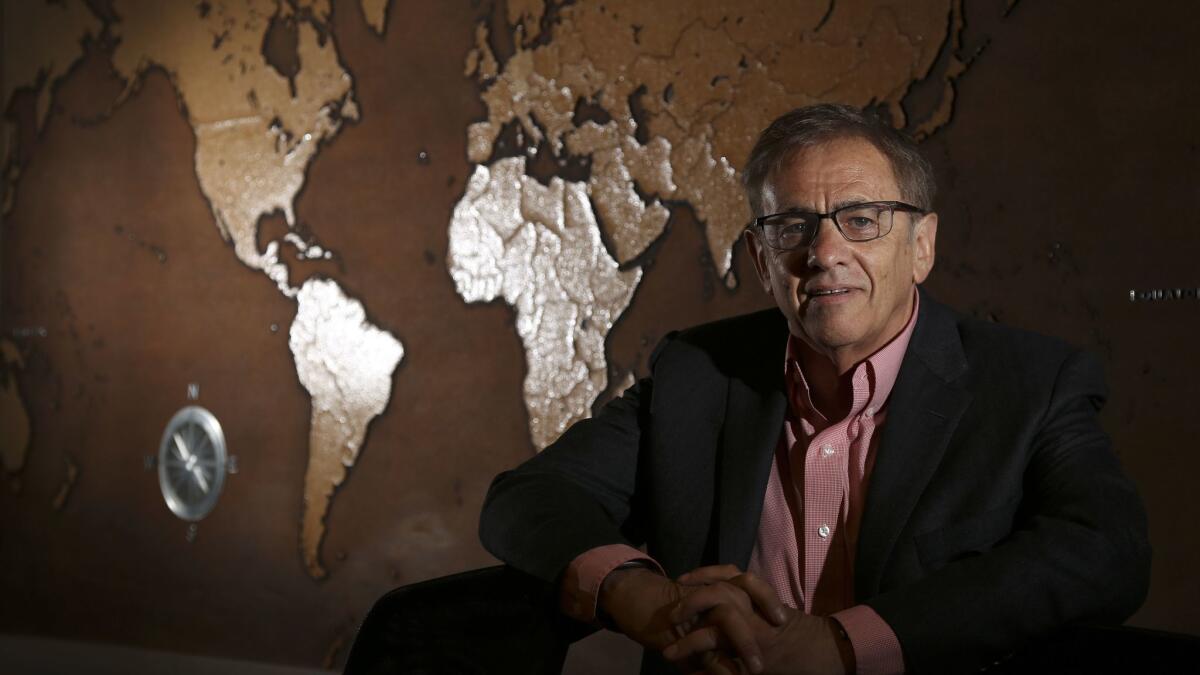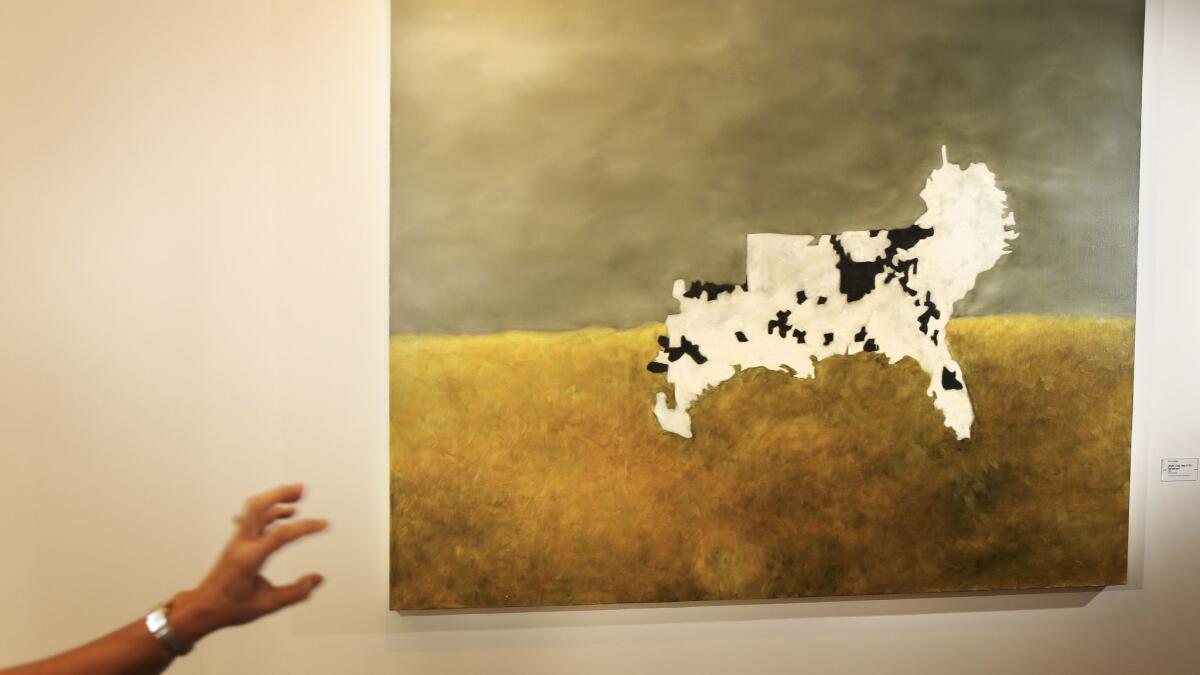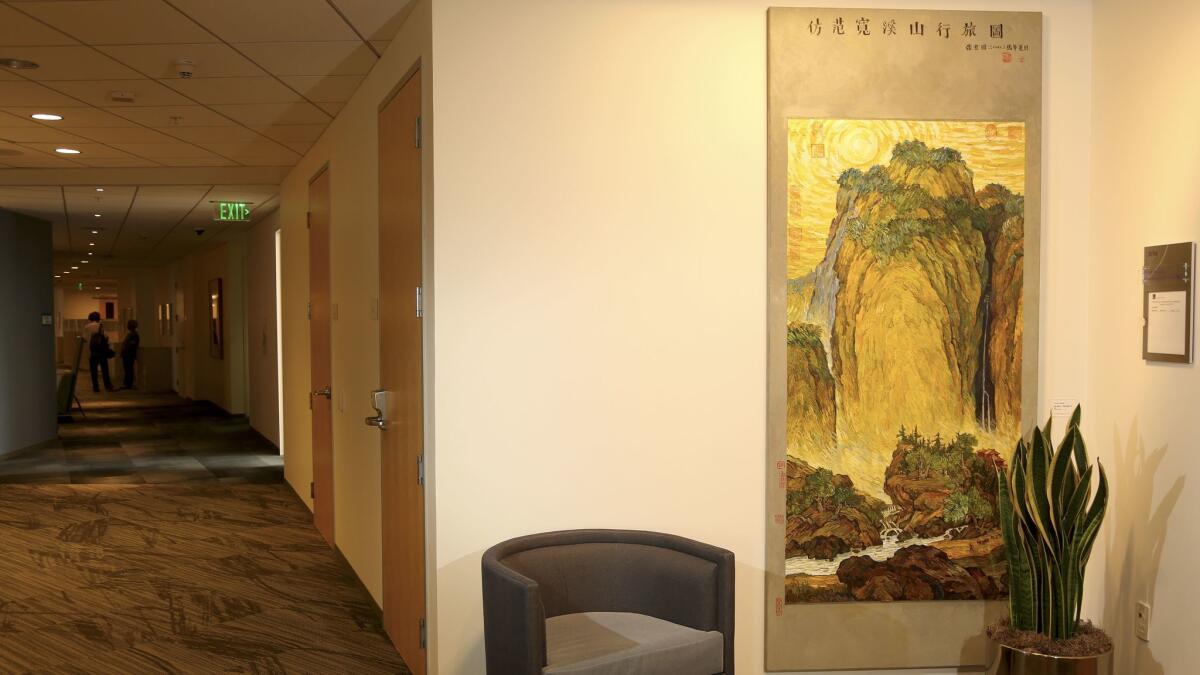Inside Rand Corp.’s impressive art collection

When David Richardson was interviewing for his job at Rand Corp. in Santa Monica, he walked by an alcove where he spotted a photograph of a Plymouth Barracuda. It looked like the work of photographer Richard Prince, an image from the artist’s “Upstate 1995-1999” series.
Richardson was impressed — and puzzled. “I wondered, ‘Why is there a Richard Prince photograph here?’ I just assumed it belonged to someone who worked there.”
The assumption was understandable. Rand is a nonprofit think tank with a reputation for expertise (54% of the staff have at least one doctorate) in fields like national security, terrorism, healthcare and economic development.
But as Richardson, an administrative assistant who has worked at Rand for about 2 1/2 years, walked from one end of the building to another, he noticed a number of artworks and artists — a mash-up of photography, paintings and lithographs from names such as John Baldessari, Nan Goldin and Catherine Opie. He learned that the Rand building is home to scores of pieces that belong to software entrepreneur and philanthropist Peter Norton, an eclectic, contemporary collection that exists as an informal, long-term loan.
And he came to understand that for many of the people who work at Rand, the art is more than a backdrop. It’s part of a unique culture, they say, that requires extreme creativity in the pursuit of solutions to some of the world’s most pressing issues. Throughout the years, the artwork has confounded, provoked and inspired employees, some of whom eagerly acknowledge their engagement.
The art, says Rand President and CEO Michael D. Rich, “triggers conversations about what the limits of human imagination are.”
It’s not as though the hallways of the Rand building, located a couple of blocks from the beach on Main Street, are teeming with boisterous researchers and pontificating analysts gesturing at various artworks. The corridors are frequently quiet; conversations are conducted in indoor voices.
But some of those conversations are about — or inspired by — the art they encounter every day in the 310,000-square-foot building.

“There’s a lot of thinking outside the box here,” says Linda Theung, a Rand research editor with a background in art and art history. “There’s a lot of problem-solving, and they are always asking questions and looking for answers. The way the people think at Rand is not 100% dissimilar to the way people think in the art world. “
Arpad Kovacs, an assistant curator at the J. Paul Getty Museum, puts it this way: “Artists come at complex ideas through new and unusual ways and that’s often what employees at Rand are tasked with.”
The artwork can be seen by employees as well as visitors who are there on business, and art groups and students who can arrange tours.
A number of other businesses in Los Angeles house (or have housed) impressive art collections that were assembled at least in part by individuals -- works that employees and visitors (and in the case of hospitals, patients) encounter in hallways, lobbies and offices. Marcia Simon Weisman and her husband Frederick R. Weisman donated hundreds of artworks to Cedars-Sinai after an expansion of the medical center in the 1970s. Lloyd Cotsen, who was chairman of Neutrogena before it was sold to Johnson & Johnson, filled the company headquarters near LAX with artifacts and folk art he’d acquired on business trips.
But the brain power at Rand and the piquancy of the art on its walls make for an unusual combination.
Theung and other employees say the collection bears little resemblance to corporate art collections in big law firms or bank headquarters. “I am sure they are very thoughtful in their acquisitions,” she says, “but I have a feeling that for a lot of corporations, it’s a client-facing thing: ‘Let us show how well off we are.’ ”
“We don’t have a Jeff Koons when you walk in,” Richardson says with a smile in his voice. “There are no rich men showing off how much money they have.”
What Rand does have are pieces like Kim Dingle’s “Lincoln’s Cow,” a work that depicts a map of the Confederacy (painted in white) with black “spots” that represent counties that refused to secede. Or Mark Bennett’s architectural drawings of the “floor plans” of the homes featured in classic TV shows like “Gilligan’s Island,” “The Addams Family” and “Bewitched.” Or Simon Patterson’s “The Great Bear,” a work that turns a map of the London Underground on its ear by replacing the names of stations with the names of stars, sports figures, saints, philosophers and explorers.
They are works that prompt observers to wonder: Who thinks of stuff like that?
Research Powerhouse
Project Rand (the name is a contraction of research and development) emerged in the aftermath of World War II, as Commanding General of the Army Air Forces H.H. “Hap” Arnold and other military and civilian leaders launched a private organization that was designed to “connect military planning with research and development decisions,” according to the company’s official history. It was incorporated as a nonprofit corporation in 1948 and earned notice in its early days for research on topics like the U.S.-Soviet nuclear arms race, satellites, intelligence gathering, digital computing, game theory, mathematical modeling, and simulation and cost analysis.

For some, Rand will always be associated with the military-industrial complex, but today the nonprofit’s list of policy experts includes researchers in fields such as human behavior, early childhood education, gender equity in the workplace and software — one of the links between Rand and Norton, a tech guru who took a $30,000 investment in software packages and books and turned it into a wildly successful business that he eventually sold for multiple millions, allowing him to become a full-time philanthropist and collector.
In 1989, Rich recalls, Norton had been asked by the United Nations Development Programme to serve on a peer-review panel to screen proposals for developing a new tech-focused university in Saudi Arabia. The review team included two Rand information scientists. “They had a lot of things in common, including an affinity for painting and other kinds of art,” Rich says. At some point the conversation turned to collecting and display space. “Our folks,” Rich says,” made the offer [to exhibit some of his art] when they heard he didn’t have enough space for his collection.”
Norton, responding to queries via email, says the initial suggestion centered on art for the Rand lobbies. “I asked, ‘Why just lobbies, why not inside?’ ” Although the building is not open to the general public, the staff, Norton says, is “like a university faculty — more than enough audience for an art collection.”
“I couldn’t give them rolling lawns and tennis courts, but I could give them the equivalent of a university art gallery. And so we proceeded.”
Norton, who sits on the advisory board of the Rand Center for Global Risk and Security, and his first wife, Eileen, became serious collectors in the 1980s. They purchased some big-name pieces but were attracted to works by up-and-coming contemporary artists, some of which were informed by social and political issues.
Gwen Hill, the collection manager at the Norton Family Office, says Norton’s current collection (including the works at Rand) comprises about 1,200 pieces, some of which are in storage in Pasadena. In recent years, Norton has donated art to the Museum of Modern Art in New York, the Hammer Museum and the Los Angeles County Museum Art. He also started a project that donates art to college and university museums, including the Frances Young Tang Teaching Museum and Art Gallery at Skidmore College and the Mary and Leigh Block Museum of Art at Northwestern University.
“We focused on institutions that teach out of their collections.” Hill says. “We wanted people to be engaged with it.”
Sense of Ownership
Susan Marquis is dean of the Pardee Rand Graduate School (the nation’s largest public policy PhD. program) and the company’s vice president for innovation. She has held senior and executive positions in the office of the Secretary of Defense and the U.S. Navy and says everyone at Rand “feels a sense of ownership” about the art. “We would be heartbroken to see it leave.” (On occasion, individual artworks are loaned to exhibitions, or sold, and new pieces are moved into the building.)

That sense of ownership is not universal; employees occasionally object to a particular artwork. “There was a Baldessari piece [titled “The Fallen Easel”] ... from that period where he [used] photographs on metal strips,” says Iao Katagiri, who retired as Rand’s community relations director last year and is a member of its adjunct staff. “It was a collage of these metal strips, and the photographs were from old movies. ... You had hands coming out with guns and knives, and we had quite a few people who said, ‘I like John Baldessari .... but this is almost like it’s glorifying violence.’ ” Eventually, the work was removed.
Even John Valadez’s “The Broadway Mural,” a highlight of the collection, has come under some scrutiny. The 60-foot-long work was painted for owners of the historic Victor Clothing Co. building in downtown Los Angeles, where it was displayed inside until the building changed hands. It depicts a vibrant parade of people in the neighborhood who are walking past merchants and shops, including a newsstand with a magazine that features partial female nudity.
That detail prompted a complaint or two, but the work remains displayed in a sleek elevator lobby. It continues to attract a high level of praise and engagement.
Will the mural and the other works find a permanent home at Rand?
Hill is enthusiastic about its current placement. (“It’s become so much a part of Rand. Nothing makes us happier than that.”) But for now the art continues to be on long-term loan. “The relationship,” she says, “will continue as long as it can continue.”
More to Read
The biggest entertainment stories
Get our big stories about Hollywood, film, television, music, arts, culture and more right in your inbox as soon as they publish.
You may occasionally receive promotional content from the Los Angeles Times.











